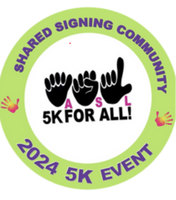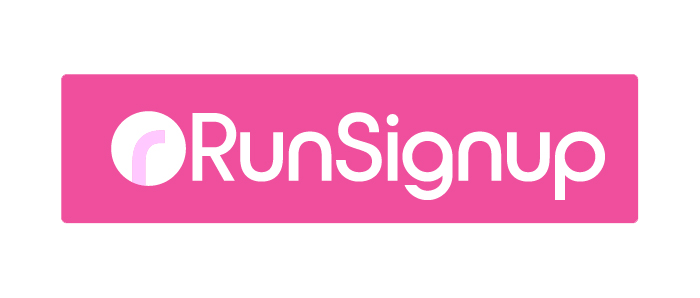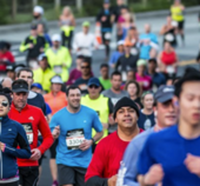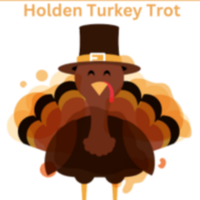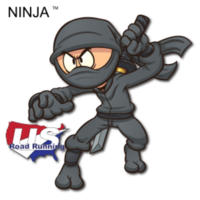Event Description
Join us for our SECOND annual ASL for All 5K fundraiser to foster Olathe as a "Shared Signing Community”! Shared signing communities are localities where both Deaf and non-Deaf community members use a shared visual language to communicate with one another. Non-signers are welcomed!
This SECOND annual ASL for All 5k fundraiser will take place on the Indian Creek Trail leading from and returning to Frontier Park. Following the 5K race, there will be two Fun-Runs for children at the park in conjunction with an ASL Festival area offering booths. ASL Performances will be provided at conclusion of Awards Ceremony. Water and refreshments will be available for free to registered participants. Check out the newsreel from our 2023 event: https://www.kshb.com/news/local-news/asl-for-all-5k-promotes-shared-signing-community-in-kansas-city-area
All proceeds from this event will be split between the Kansas School for the Deaf Endowment Association (KSDEA) and Museum of Deaf History, Arts & Culture (MDHAC) in support of their missions in fostering shared signing communities.
MORE INFORMATION
Kansas School for the Deaf Endowment Association:
A 501(c)(3) tax-exempt organization that is independent of the Kansas School for the Deaf (KSD) and is focused on managing a fund to provide support for students' continued growth and enrichment outside of the classrooms. Since KSD is a state-funded school, KSD depends on endowment contributions to meet students' needs that are not provided by state funding such as camps, field trips, dormitory social/ instructional activities (including cultural activities at MDHAC) and/or technology support and other individual needs. More information about KSD and the endowment can be found here: www.ksdeaf.org
Museum of Deaf History, Arts & Culture, Inc. (MDHAC):
MDHAC is also a 501(c)(3) tax-exempt organization that is dedicated with the mission to advance and preserve information about Deaf people, their languages, cultures, and experiences in the United States and around the world. As the first independently run museum about Deaf people, all of MDHAC's contributions goes toward operating support and programming that promotes the advantages of signed languages for ALL humans whether they are Deaf or non-Deaf and elevating Deaf people's stories through history, arts and culture. We offer self-guided or docent tours and immersive hands-on activities. You can find out more by going to www.MuseumofDeaf.org. Our tax identification number is 48-6282776.
American Sign Language (ASL):
ASL is a natural language that serves as the most predominant sign language of Deaf communities in the United States of America and most of Anglophone Canada. ASL is NOT signing in or shorthand for English. It is a complete and organized visual language that is expressed by employing both manual and non-manual features. It is a natural language that has the same linguistic properties as spoken language, with its own grammar, syntax and vocabulary.
ASL originated more than 200 years ago from the intermixing of local Native American sign language, French Sign Language, and Martha’s Vineyard Sign language (developed signs from a once-thriving shared signing community on the island of Martha’s Vineyard). While ASL is the most predominant, there is growing recognition of the use of Black American Sign Language, Plains Indian Sign Language, and Mexican Sign Language in the United States.
Currently, other than English, ASL is the third-most taught language at high schools, colleges, and universities after Spanish and French. For more information about where you can take ASL classes, please check with your local high school, Johnson County Community College (JCCC), and the University of Kansas (KU)- Edwards Campus.
Shared Signing Communities:
Shared signing communities are defined as communities where BOTH Deaf people and non-Deaf use sign language to communicate with each other in the areas where they live, work, congregate, or play. Such places are regarded as different from the mainstream where deaf people mostly are surrounded by hearing, non-signing people in their families, schools, and workplaces. It is believed that shared signing communities have existed on Earth for thousands of years in various countries. The most notable in the United States of America is Martha’s Vineyard from the early 18th century to the early 1950’s. For a time, it was known as a place where “everyone spoke sign language”. For more information about the history of Deaf people on Martha’s Vineyard, please view: https://www.youtube.com/watch?v=_Ioi7COpA7A
How Signed Language Benefits All:
Using signed language allows you to communicate with everyone in your environment without barriers or frustrations to anyone. Signing conversations are efficient and you can go deeper in the conversations without cutting out details. Sign language is good for the brain, boosting cognition, creativity, functionality, memory, spatial awareness, mental rotation skills, and more! Signing increases your visual field responses as you become more aware of the things you see and reacting more quickly. And maybe more importantly, using sign language increases your bond and connection with others where you can be more in tune with others’ emotions and nuances. Babies, both Deaf or non-Deaf, can use sign language as early as 6 months, and this jump-starts the building blocks of language which provides babies with many benefits that would last a lifetime!
